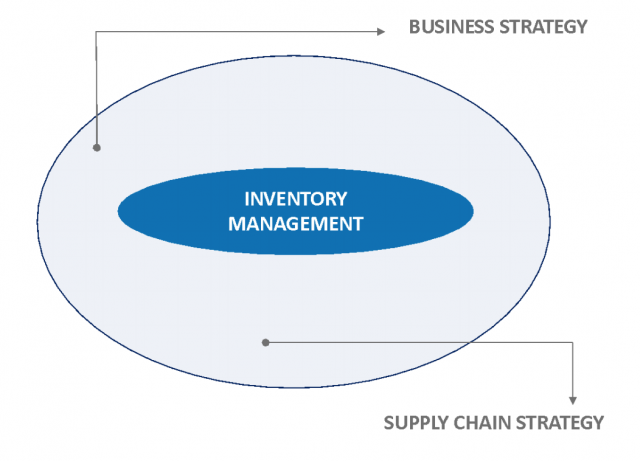What is Inventory Management? Is it about optimization? Is it about having enough stock? Or is it about having no stock? The answer varies from function to function in the supply chain.
- For Sales it’s about product availability at all times
- For Manufacturing it’s about carrying zero or minimum inventory
- For Logistics the focus is on high inventory turns
- For Management: a balancing strategy, etc…
Inventory Management is about having a right balance of expectations from different functions of the supply chain. It is about keeping all (well most) of the stakeholders of the supply chain content and taking into consideration the supply chain strategy of the organization.
Inventory Management is a function that should always be in sync with your supply chain strategy and in turn depends on your overall business strategy.

Inventory Management: There’s No One-Size-Fits-All Approach
Is there a common trend in inventory management? Not really because each industry is different, and so are organizations within the same industry and even different divisions within the same organization have their own unique drivers and constraints. Hence following so-called industry trends may not always yield targeted results.
Example A: Fashion Retailer – Business Strategy is short life cycle products. What does it mean for inventory? Faster turn over.
Example B: Supermarket Retailer – Business strategy is to have low cost to compete effectively. Focus on availability of products all the time, price, and range. Hence buying well is key, which means relatively more inventory.
Example C: Oil & Gas – Products and services are diverse. Widely dispersed and remotely located customers. Inventory is lower but focus on faster service and hence not cost-sensitive.
Managing inventory is crucial because of varying internal, customer, and market reasons. Increased demand fluctuations, reduced product life cycle, long and complex supply chains, and the rising cost of capital are only adding to complexities.
The results of better inventory management are reflected in four broad areas:
- Reduced Inventory Carrying Costs
- Reduced Inventory Obsolescence Cost
- Reduced lead times to customers
- Increased perfect order %
There are broadly three stages of inventory management in supply chain: Manufacturing Support; Finished/Manufactured Goods; and After-Sale Support. Planning and management in each stage is differentiated by their key driver, method, and service level.
| Stages |
Key Driver |
Method |
Service Level |
| Manufacturing Support |
Cost of Manufactured Goods |
Just in Time, Just in Sequence, VMI etc… |
Scheduled Date & Time |
| Manufactured Goods |
Sales Strategy |
Make to Stock, Make to Order |
Off the shelf to ‘n’ number of days depending on supply lead time |
| After-Sale Support |
Customer service level |
Replenishment |
1hr, 2hr, SBD, NBD…. weeks |
So how do you measure the effectiveness of your inventory management? There are several KPIs such as cash-to-cash cycle, inventory turns, order fill rate, backorder rate, dead inventory write-offs, etc. KPIs should provide a feel of effectiveness in inventory management but actions needing to improve the performance lies where the challenges are.
As the complexity of global supply chains are increasing, Inventory Planning and Management has become a challenging task for many organizations irrespective of their supply chain maturity, especially in the after-sales market.
Overcoming the Challenges
So how do you overcome this challenge?
For the companies we work with, we leverage an Inventory Planning & Management System (IP&M System) to address this challenge. It is a package of methodologies and statistical models developed to perform inventory rationalization and improve service within the logistics industry. This system uses Multi-Echelon Planning as a base combined with statistical models we developed that are applied at different phases of the exercise.
It starts with assessing the inventory health of an organization; root cause analysis is performed at strategic, tactical and operational levels; and then recommendations are proposed. A management system is designed to focus on the key sources of issues that might impact overall inventory health and serviceability of an organization.
 Madhusudan Shankar is head of the Business Solutions team for GEODIS in APAC. His responsibilities include designing sustainable supply chain solutions for clients. His expertise includes after sales supply chain operations, contract logistics, 4PL, inventory planning & management and business development support functions. He was the chief architect of the Inventory Planning & Management System (IP&M System) developed by GEODIS. He has also successfully lead deployment of the IP&M System for customers in various verticals including High-Tech and Industrial after sales market.
Madhusudan Shankar is head of the Business Solutions team for GEODIS in APAC. His responsibilities include designing sustainable supply chain solutions for clients. His expertise includes after sales supply chain operations, contract logistics, 4PL, inventory planning & management and business development support functions. He was the chief architect of the Inventory Planning & Management System (IP&M System) developed by GEODIS. He has also successfully lead deployment of the IP&M System for customers in various verticals including High-Tech and Industrial after sales market.
Inventory Management in Service Logistics Industry
What is Inventory Management? Is it about optimization? Is it about having enough stock? Or is it about having no stock? The answer varies from function to function in the supply chain.
Inventory Management is about having a right balance of expectations from different functions of the supply chain. It is about keeping all (well most) of the stakeholders of the supply chain content and taking into consideration the supply chain strategy of the organization.
Inventory Management is a function that should always be in sync with your supply chain strategy and in turn depends on your overall business strategy.
Inventory Management: There’s No One-Size-Fits-All Approach
Is there a common trend in inventory management? Not really because each industry is different, and so are organizations within the same industry and even different divisions within the same organization have their own unique drivers and constraints. Hence following so-called industry trends may not always yield targeted results.
Example A: Fashion Retailer – Business Strategy is short life cycle products. What does it mean for inventory? Faster turn over.
Example B: Supermarket Retailer – Business strategy is to have low cost to compete effectively. Focus on availability of products all the time, price, and range. Hence buying well is key, which means relatively more inventory.
Example C: Oil & Gas – Products and services are diverse. Widely dispersed and remotely located customers. Inventory is lower but focus on faster service and hence not cost-sensitive.
Managing inventory is crucial because of varying internal, customer, and market reasons. Increased demand fluctuations, reduced product life cycle, long and complex supply chains, and the rising cost of capital are only adding to complexities.
The results of better inventory management are reflected in four broad areas:
There are broadly three stages of inventory management in supply chain: Manufacturing Support; Finished/Manufactured Goods; and After-Sale Support. Planning and management in each stage is differentiated by their key driver, method, and service level.
So how do you measure the effectiveness of your inventory management? There are several KPIs such as cash-to-cash cycle, inventory turns, order fill rate, backorder rate, dead inventory write-offs, etc. KPIs should provide a feel of effectiveness in inventory management but actions needing to improve the performance lies where the challenges are.
As the complexity of global supply chains are increasing, Inventory Planning and Management has become a challenging task for many organizations irrespective of their supply chain maturity, especially in the after-sales market.
Overcoming the Challenges
So how do you overcome this challenge?
For the companies we work with, we leverage an Inventory Planning & Management System (IP&M System) to address this challenge. It is a package of methodologies and statistical models developed to perform inventory rationalization and improve service within the logistics industry. This system uses Multi-Echelon Planning as a base combined with statistical models we developed that are applied at different phases of the exercise.
It starts with assessing the inventory health of an organization; root cause analysis is performed at strategic, tactical and operational levels; and then recommendations are proposed. A management system is designed to focus on the key sources of issues that might impact overall inventory health and serviceability of an organization.
TAGS
Subscribe to Our YouTube Channel
TOPICS
Categories
Subscribe to Our Podcast
TRENDING POSTS
Sponsors